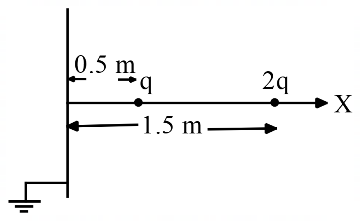81. In a two beam interference pattern, the maximum and minimum intensity values are found to be 25$${I_0}$$ and 9$${I_0}$$ respectively, where $${I_0}$$ is a constant. The intensities of the two interfering beams are
82. Two charges q and 2q are placed along the X-axis in front of a grounded, infinite conducting plane, as shown in the figure. They are located respectively at a distance of 0.5 m and 1.5 m from the plane. The force acting on the charge q is


83. At time t = 0, a charge distribution $$\rho \left( {\overrightarrow {\bf{r}} ,\,0} \right)$$ exists within an ideal homogeneous conductor of permittivity $$\varepsilon $$ and conductivity $$\sigma $$. At a later time $$\rho \left( {\overrightarrow {\bf{r}} ,\,t} \right)$$ is given by
84. For a vector potential $$\overrightarrow {\bf{A}} ,$$ the divergence of $$\overrightarrow {\bf{A}} $$ is $$\overrightarrow \nabla \cdot \overrightarrow {\bf{A}} = - \frac{{{\mu _0}}}{{4\pi }} \cdot \frac{Q}{{{r^2}}},$$ where Q is a constant of appropriate dimension. The corresponding scalar potential $$\phi \left( {r,\,t} \right)$$ that makes $$\overrightarrow {\bf{A}} $$ and $$\phi $$ Lorentz gauge invariant is
85. A sphere of radius R has uniform volume charge density. The electric potential at a point r (r < R) is
86. A solid sphere of radius R carries a uniform volume charge density $$\rho $$ . The magnitude of electric field inside the sphere at a distance r from the centre is
87. Which of the following expressions for a vector potential $$\overrightarrow {\bf{A}} $$ does not represent a uniform magnetic field of magnitude B0 along the Z-direction?
88. The XOY - plane carries a uniform surface current of density $$\overrightarrow {\bf{K}} = 50\,{{\bf{\hat e}}_z}$$ A/m. The magnetic fields at the point z = -0.5 m is
89. The electric field E(r, t) at a point r at time t in a metal due to the passage of electrons can be described by the equation $${\nabla ^2}\overrightarrow {\bf{E}} \left( {\overrightarrow {\bf{r}} ,\,t} \right) = \frac{1}{{{c^2}}}\left[ {\frac{{{\partial ^2}\overrightarrow {\bf{E}} \left( {\overrightarrow {\bf{r}} ,\,t} \right)}}{{\partial {t^2}}} + \omega {'^2}\overrightarrow {\bf{E}} \left( {\overrightarrow {\bf{r}} ,\,t} \right)} \right]$$
where, $$\omega '$$ is a characteristic associated with the metal and c is the speed of light in vacuum. The dispersion relation corresponding to the plane wave solutions of the form exp $$\left[ {i\left( {\overrightarrow {\bf{i}} .\overrightarrow {\bf{r}} - \omega t} \right)} \right]$$ is given by
where, $$\omega '$$ is a characteristic associated with the metal and c is the speed of light in vacuum. The dispersion relation corresponding to the plane wave solutions of the form exp $$\left[ {i\left( {\overrightarrow {\bf{i}} .\overrightarrow {\bf{r}} - \omega t} \right)} \right]$$ is given by
